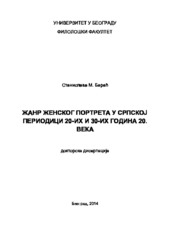Приказ основних података о дисертацији
Жанр женског портрета у српској периодици 20-их и 30-их година 20. века
The female portrait genre in Serbian periodicals of the 1920's and 1930's
| dc.contributor.advisor | Dojčinović, Biljana | |
| dc.creator | Barać, Stanislava | |
| dc.date.accessioned | 2016-01-05T13:42:44Z | |
| dc.date.available | 2016-01-05T13:42:44Z | |
| dc.date.available | 2020-07-03T12:22:32Z | |
| dc.date.issued | 2014-07-10 | |
| dc.identifier.uri | https://nardus.mpn.gov.rs/handle/123456789/4076 | |
| dc.identifier.uri | http://eteze.bg.ac.rs/application/showtheses?thesesId=2177 | |
| dc.identifier.uri | https://fedorabg.bg.ac.rs/fedora/get/o:10012/bdef:Content/download | |
| dc.identifier.uri | http://vbs.rs/scripts/cobiss?command=DISPLAY&base=70036&RID=47173903 | |
| dc.description.abstract | Рачунајући од времена Француске револуције и пионирских покушаја Олимп де Гуж и Мери Вулстонкрафт, Први светски рат представљао је најважнију прекретницу у схватању женских права у европским друштвима. Нагли улазак великог броја жена у привредни живот земаља у рату показао је у кратком периоду да су жене у свему способне подједнако као и мушкарци, што је, независно од рата, учинила и комунистичка револуција у Совјетском Савезу. То је драстично променило погледе, али и аргументацију, о женској инфериорности, као и о подељености привате и јавне сфере и одговарајућим родним улогама. Линија прогресивних промена у озакоњењу женских права и промена у родним односима као друштвеним односима моћи уопште током 20- их и 30-их година 20. века била је, истина, прекидана и нарушавана, али су многа од тадашњих постигнућа постала трајне цивилизацијске тековине. Ове промене, као и формирање нове, велике државе – Краљевине Срба, Хрвата и Словенаца / Југославије (1919–1941), омогућили су нагли и упадљив продор жена у јавни живот и у Србији. У тим условима формирана је и феминистичка контрајавност, чији су основни инструменти били часописи и листови који су уређивале саме жене. Док су до 1914. године на српском језику доминирали часописи намењени женама које су уређивали мушкарци, уз изузетке на подручју Аустроугарске монархије какви су били часопис Жена (уреднице Милице Томић) и алманах Српкиња (који су уредиле „српске књижевнице“), од почетка 20-их година појављују се гласила којима су жене и власнице и уреднице и главне сараднице. У таквим околностима развио се и раширио жанр женског портрета који је подразумевао писање жена о одабраним женама и женским идентитетима са циљем женске еманципације... | sr |
| dc.description.abstract | Since the French revolution and the pioneering efforts of Olympe de Gouges and Mary Wollstonecraft, World War I presented the most important turning point in the understanding of women’s rights in European societies. The sudden entrance of a large number of women into the economies of warring countries demonstrated, in a short period, that women are as capable as men for any type of work, as the communist revolution in USSR already had demonstrated independently from the war. This drastically altered the views and argumentation about female inferiority, as well as the views on the separation of the private and the public sphere and corresponding gender roles. The streak of progressive changes in legalising women’s rights and general alterations of gender relations as social power relations in the 1920’s and 1930’s was interrupted and interfered with, but many achievements of that time became lasting civilisation legacies. These changes, as well as the foundation of a new, large state – the Kingdom of Serbs, Croats and Slovenians / Yugoslavia (1919–1941), enabled a sudden and noticeable intrusion of women into Serbian public life. A feminist counterpublic was created in those circumstances; its basic instruments were magazines and journals edited by women themselves. While the period ending with 1914 was dominated by Serbian journals intended for women yet edited by men, with some exceptions in the Austro-Hungarian monarchy, such as the journal Žena (The Woman, edited by Milica Tomić) and the almanac Srpkinja (The Serbian Woman, edited by “Serbian women of letters”), the early twenties witnessed the appearance of journals owned, edited and mostly written by women. Such circumstances benefited the development and popularity of the female portrait genre, involving women’s writing about selected women and female identities with the aim of female emancipation... | en |
| dc.format | application/pdf | |
| dc.language | sr | |
| dc.publisher | Универзитет у Београду, Филолошки факултет | sr |
| dc.rights | openAccess | en |
| dc.rights.uri | https://creativecommons.org/licenses/by-nc-nd/4.0/ | |
| dc.source | Универзитет у Београду | sr |
| dc.subject | женски портрет | sr |
| dc.subject | female portrait | en |
| dc.subject | жанр | sr |
| dc.subject | српска периодика | sr |
| dc.subject | Краљевина Срба | sr |
| dc.subject | Хрвата и Словенаца | sr |
| dc.subject | феминистичка контрајавност | sr |
| dc.subject | нова жена | sr |
| dc.subject | идентитет | sr |
| dc.subject | род | sr |
| dc.subject | женска књижевност | sr |
| dc.subject | модернизацијски процеси | sr |
| dc.subject | феминизам | sr |
| dc.subject | genre | en |
| dc.subject | Serbian periodicals | en |
| dc.subject | Kingdom of Serbs | en |
| dc.subject | Croats and Slovenians | en |
| dc.subject | feminist counterpublic | en |
| dc.subject | the new woman | en |
| dc.subject | identity | en |
| dc.subject | gender | en |
| dc.subject | women’s literature | en |
| dc.subject | modernization processes | en |
| dc.subject | feminism | en |
| dc.subject | Југославија | sr |
| dc.subject | Yugoslavia | en |
| dc.title | Жанр женског портрета у српској периодици 20-их и 30-их година 20. века | sr |
| dc.title | The female portrait genre in Serbian periodicals of the 1920's and 1930's | en |
| dc.type | doctoralThesis | en |
| dc.rights.license | BY-NC-ND | |
| dcterms.abstract | Дојчиновић, Биљана; Бараћ, Станислава; Žanr ženskog portreta u srpskoj periodici 20-ih i 30-ih godina 20. veka; | |
| dc.identifier.fulltext | https://nardus.mpn.gov.rs/bitstream/id/32175/Disertacija.pdf | |
| dc.identifier.fulltext | http://nardus.mpn.gov.rs/bitstream/id/32175/Disertacija.pdf | |
| dc.identifier.rcub | https://hdl.handle.net/21.15107/rcub_nardus_4076 |


